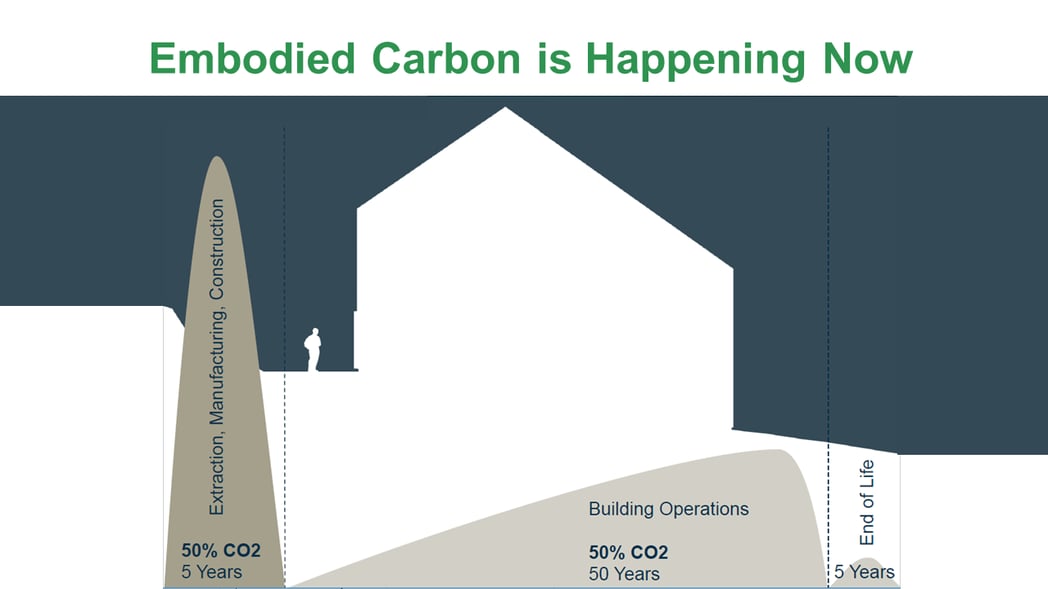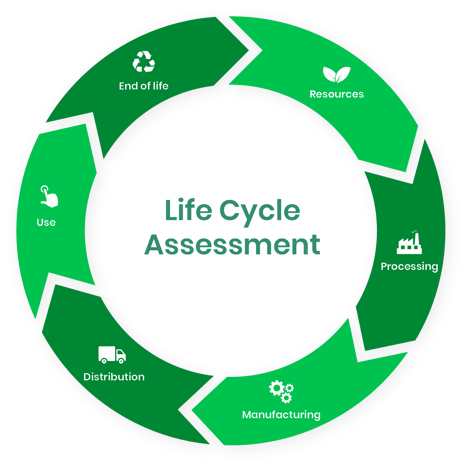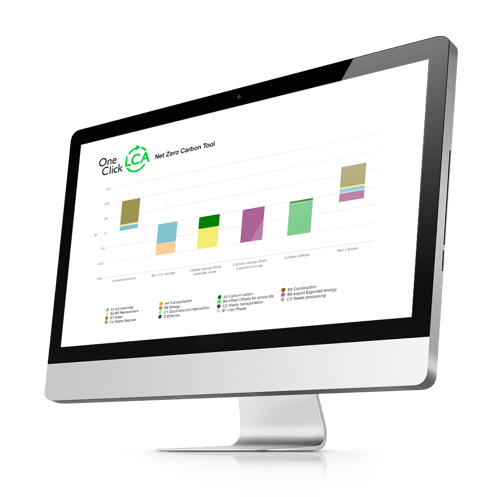
Each week, we construct a city the size of Paris across the globe. Surprisingly, less than 1% of buildings have their carbon footprints assessed, and even fewer have a detailed analysis of the two different types of carbon: embodied and operational. Our shared goal in the Paris Agreement is to achieve global net-zero carbon emissions by 2050. To reach the lofty goals of the Paris Agreement, it’s vital to understand the differences between embodied carbon vs. operational carbon and their roles in climate change.
Embodied carbon vs. operational carbon
The built environment is a major contributor to global climate change – it is responsible for about 40% of annual CO2 emissions. This carbon comes from two sources: embodied and operational. Most people are familiar with operational carbon – the carbon used in operating and using a building. This includes things like:
-
Lighting
-
Heating
-
Ventilation
-
Cooling, or air conditioning
-
General power usage throughout the building
The operational carbon footprint of a building is the sum of all the carbon produced over the lifetime use of the building, which could easily be 50 or more years.
Embodied carbon is the carbon footprint of a building before it is built, and encompasses the greenhouse gasses emitted during the construction process. This includes things like:
-
Extraction and production of materials
-
Transportation of materials
-
Manufacturing
- Construction
-
Demolition and retrofitting
-
End-of-life deconstruction
Embodied carbon is the “upfront carbon” that is generated before the building is used.
40% of annual CO2 emissions come from the built environment, and 13% of those come from upfront, or embodied, carbon.
If only 13% of emissions from buildings come from embodied carbon, why do we focus on it? Because that carbon is being released into the atmosphere now, not over the next 50 or more years. If we can reduce embodied carbon now, we can have a significant impact on reducing the overall effects of climate change more quickly.
Additionally, our energy grid is getting cleaner. Over the last 50 years, the architecture, engineering and construction (AEC) industry has focused on making buildings more energy efficient. This means that buildings are using less energy overall, and the energy they are using is coming from cleaner sources.
Making buildings more energy efficient has lowered carbon operating emissions. But as operational carbon goes down, embodied carbon will account for a larger percentage of total carbon. By the year 2050, almost half of the carbon footprint in new construction will come from embodied carbon. Canada, Sweden, and Norway are already seeing an almost 50/50 embodied carbon vs. operating carbon split. This is because these countries have done a good job of reducing their use of fossil fuels and moved toward renewable energy sources. We need to start paying more attention to embodied carbon now if we want to make a difference in the future.

The true cost of embodied carbon
As we decarbonize the grid, operational carbon emissions will gradually decrease. But since embodied carbon is spent before the building is used, it is a sunk cost and cannot be reduced after building completion. As we strive for net zero by 2050, embodied carbon will play a crucial role in whether or not we succeed.
Our carbon “budget” between now and 2050 is 420 GT (gigatons). That is the amount of carbon we can emit over the next 27 years, and still achieve the goals of The Paris Agreement. Right now, we are drastically overspending that budget: at the current rate of 53GT per year, we are on track to hit 1325 GT by 2050. To reduce this spending spree, we must tackle carbon that is emitted now – which is where embodied carbon comes into play.
The urgent need for measurement and reduction
Life-cycle assessment (LCA)
Life-cycle assessment (LCA) is a way to understand the environmental impact of building something, like a house or a bridge, from start to finish. One Click LCA offers the tools you need to make this complicated process simple.
Here’s how it works:
Materials (embodied carbon): The first step is to look at all the materials needed for the construction. This includes things like wood, concrete, and steel. We track where these materials come from and how they are made, following the product from the forest or mine to delivery to the construction site.
Building (embodied carbon): Next, we examine how the construction process itself affects the environment. This involves looking at the energy used, the waste produced, and the emissions released during building.
Use (operational carbon): After the construction is complete, we consider how the building will be used. For example, in a commercial building, we might look at how the HVAC is set up to determine an estimate of life time energy usage.
End of life: Finally, we think about what happens when the building is no longer used or needs to be replaced. Will it be demolished? Can parts of it be recycled or reused?
 By going through these steps, we get a complete picture of how the building impacts the environment throughout its life. This helps us find ways to make construction more eco-friendly and sustainable, right from the very beginning.
By going through these steps, we get a complete picture of how the building impacts the environment throughout its life. This helps us find ways to make construction more eco-friendly and sustainable, right from the very beginning.
The goal of an LCA is to build structures in a way that minimizes their negative impact on the environment. LCAs make sure we’re moving toward our carbon reduction targets. In the past, measuring and tracking embodied carbon has been challenging. However, our software at One Click LCA makes it fast and easy to measure embodied carbon.
By using less material overall and swapping high carbon materials for lower emitters, construction companies can help us hit our 2050 goals. It doesn’t have to be expensive either. One Click LCA has helped clients reduce their embodied emissions by 30% without increasing their expenses – some even saving money on their projects.
Other measures we can take today
Reduce the number of materials: The first and most important. Reducing the amount of materials used can significantly reduce the overall embodied carbon in a project. This almost always results in lower costs too.
Choose low-carbon materials: Opt for materials that have a lower carbon footprint during their production. For example, using sustainably sourced wood instead of concrete or steel can significantly reduce embodied carbon.
Recycled and reused materials: Instead of always using new materials, we can recycle and reuse materials from old buildings or other sources. This reduces the need for new production and saves energy.
Energy-efficient construction techniques: Employ construction methods that require less energy. For example, using pre-fabricated components can be more energy-efficient compared to traditional on-site construction.
Design for longevity: Construct buildings that are durable and long-lasting. This way, they stay in use for a more extended period, and we don’t need to build new ones as frequently.
Design for adaptability: Create buildings that can easily adapt to changing needs. This way, we can avoid tearing down and rebuilding structures when requirements change, which saves embodied carbon.
Retrofit existing buildings: Retrofits offer an opportunity to cut carbon emissions and extend the building’s life. Reusing buildings can save 50-75% of embodied carbon emissions, especially if we maintain the foundation. We can also choose materials with lower carbon footprints, such as recycled steel.
Education and awareness: Raise awareness among construction professionals, builders, and the public about the importance of reducing embodied carbon. When everyone is on board, we can work together for a greener construction industry.
One Click LCA is passionate about spreading awareness. That’s why we have free training and certification in things like LCA, EPD, whole-life carbon, circularity, and life cycle costing.
The urgency of the climate crisis demands immediate action to reduce embodied carbon. Organizations like SE2050, Infra2050, the Carbon Leadership Forum, and the World Green Building Council have committed to achieving net zero embodied carbon from buildings by 2050. Building codes, regulatory policies, and procurement initiatives are being developed to incentivize low-carbon materials and sustainable building practices.
Regulatory push for decarbonization
Governments play a big role in encouraging the construction industry to reduce embodied carbon. Here’s how they can help:
Setting standards and regulations: Governments can create standards that require builders to meet certain environmental criteria. For example, they can set limits on the amount of carbon emissions or mandate the use of specific eco-friendly materials. Initiatives like the Buy Clean Act are making it mandatory for manufacturers to provide embodied carbon data when selling to various government agencies. US states like California, New York, Washington, Colorado, and Minnesota, have already passed “Buy Clean” laws that target embodied emissions.
Vancouver’s Zero Emissions Building Plan serves as a compelling case study addressing embodied carbon. By requiring builders to calculate embodied carbon, Vancouver aims to achieve a 40% reduction in embodied carbon by 2030. This early calculation empowers builders to opt for lower-carbon materials. The city will also soon add an embodied carbon threshold to its building codes.
Incentives and subsidies: Governments can offer financial incentives or subsidies to construction companies that adopt greener practices. This can include tax breaks for using low-carbon materials and energy-efficient construction methods. For instance, New Jersey is introducing tax credits for concrete producers that meet low embodied carbon baselines.
Supporting research and development: Governments can invest in research and development of new construction technologies, processes, and materials that have a lower carbon footprint. They can fund projects to explore innovative ways to reduce embodied carbon and share the findings with the industry.
Promoting green building certifications: Governments can encourage the adoption of green building certification systems like LEED (Leadership in Energy and Environmental Design) or BREEAM (Building Research Establishment Environmental Assessment Method). These certifications promote sustainable building practices and help reduce embodied carbon.
Public procurement policies: Governments themselves are significant consumers of construction projects. By using sustainability requirements like Buy Clean, governments can lead by example and set the bar for low-carbon construction.
Education and awareness: Governments can educate the public, construction professionals, and builders about the importance of reducing embodied carbon. Raising awareness helps create a culture of sustainability and encourages everyone to be mindful of the environment in construction projects.
Supporting infrastructure for sustainable materials: Governments are investing in infrastructure to facilitate the use of sustainable materials. For instance, they can support the establishment of recycling centers for construction waste or provide resources for the production of low-carbon building materials.
Building codes and permits: Governments can update building codes and permit processes to include sustainability. This ensures that new construction projects meet certain environmental standards right from the planning stage. In the United States, the Inflation Reduction Act has set aside $1 billion in grants to help states establish new residential and commercial building codes. Companies must be proactive in preparing for these upcoming regulations.
Collaboration with the industry: Governments can work closely with the construction industry to understand their challenges and needs in transitioning to low-carbon practices. Collaborative efforts can lead to more effective policies and solutions.
Embodied carbon and the “Carbon Loophole”
Some countries have figured out that they can take action to reduce carbon emissions within their borders while increasing in emissions in other regions. This occurs when industries move their production to areas with less stringent climate regulations to avoid higher costs associated with carbon emissions in their home country. They can look like they’re doing well in reducing emissions when they’re actually not.
This is a problem because it means we might not be doing as much to stop climate change as we thought. If we don’t count the greenhouse gasses that are hidden in the things we trade between countries, we’re missing an important part of the puzzle. And without that piece, many of the good things we’re doing to fight climate change might not make as big a difference as we hoped.
This loophole accounts for around 25% of global emissions present in traded goods. Different countries and regions are currently discussing and implementing various policies to address the carbon loophole and carbon leakage. For instance, the U.S., Canada, and the UK are considering a border carbon adjustment, while the EU already has plans for a border adjustment in place. Other policies that are already put into action include Buy Clean and Green Public Procurement (GPP).
We can also track the supply chain of our products through EPDs (Environmental Product Declarations) and know to a higher degree of certainty what the footprints of our products are.
These measures aim to address hidden carbon emissions from goods traded internationally and close the carbon loophole.
A collaborative effort towards Net-Zero
Cities are expected to double by 2060, adding an extra 230 gigatons of embodied carbon to the atmosphere. This puts us at almost 400% of our gigaton budget. It is more important than ever to address embodied carbon. By designing with embodied carbon reduction in mind, improving existing buildings to save energy, encouraging the use of low-carbon materials, and using tools like One Click LCA, we can positively impact the climate crisis. The urgency of the climate crisis requires builders, designers, users, policymakers, financiers, and underwriters to take immediate action and lead the way to a greener future. Let’s seize this opportunity and build a sustainable future, one carbon-conscious structure at a time.


